Our pets are cherished family members, so why not create a home that’s comfortable for them? We’ll show you 10 pet-friendly projects that go beyond the typical dog house. These budget-friendly, easy-to-complete DIY ideas add thoughtful features for your pet’s comfort while keeping your home both stylish and functional.

1. Build a Dog Gate
Whether it keeps his muzzle away from the dinner table or stops him from getting underfoot during parties, a dog gate is a handy tool for setting proper boundaries for your pooch. To create a gate that matches your home’s decor, use materials that complement your existing interior design. Add design elements like decorative panels or a custom paint job to turn a simple barrier into an attractive home feature.
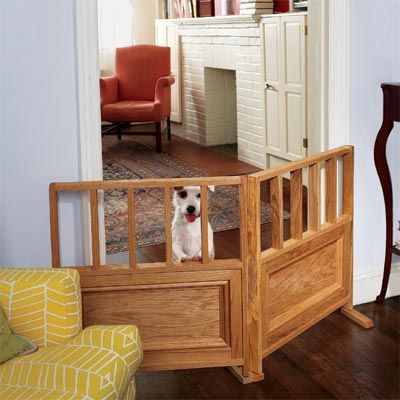
Make sure the gate is strong enough to withstand your pet’s size and strength. Install a secure latch mechanism that’s easy for humans to operate but challenging for pets to figure out. For added convenience, consider making the gate removable or foldable for easy storage when not in use. An adjustable height feature can also be valuable, allowing the gate to adapt as your pet grows or as needed for different sections of the home.
2. Build a Dog Crate
A custom-built wooden dog crate can provide your pet with a cozy retreat while doubling as an attractive piece of furniture. When designing your dog crate, add elements like a soft, removable bed, good ventilation, and durable, easy-to-clean materials. You can customize it with decorative elements like reproduction heating grates or ornamental panels.
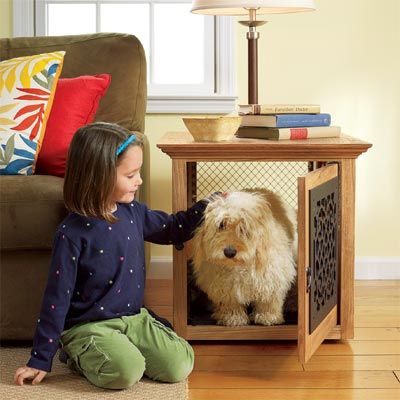
You can add storage space for pet supplies or design the crate top as a side table. You could also add charging ports or small shelves for items like books or remote controls, blending pet care and home organization.
3. Build a Dog Feeding Station
An organized and elevated feeding station helps keep your kitchen tidy and offers ergonomic benefits for your dog. It is especially useful for larger breeds or older pets who may struggle with bending down to eat.
You can add storage for food, treats, and other pet supplies. This could include pull-out drawers for kibble or shelves for canned food. Choose materials that are easy to clean and maintain, such as sealed wood or stainless steel. Avoid porous materials that can harbor bacteria and odors. Don’t forget to include a built-in water dispenser or a raised lip around the feeding area to contain spills, and adjust the feeding station’s height for your pet’s comfort.
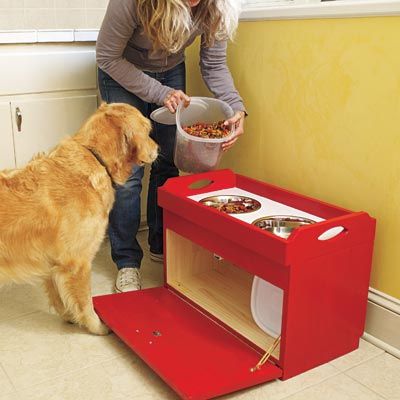
4. Build a Wall-Mounted Pet Organizer
A wall-mounted organizer for pets stores all your pet’s essentials in one easily accessible place. This project will help you keep everything you need for walks and outings at your fingertips, making your daily routine easier. When creating your organizer, include hooks for leashes and collars, a shelf for treats and toys, and a dispenser for waste bags. You can also add a small whiteboard or chalkboard to note important reminders or upcoming vet appointments.
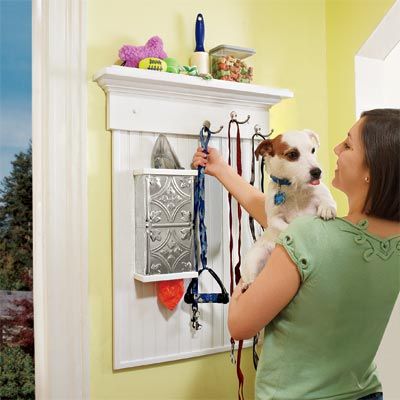
Try using materials that complement your home’s decor, such as reclaimed wood for a rustic look or sleek metal for a modern touch. Add personalized elements like your pet’s name or a favorite photo. Use small baskets or compartments to keep things organized.
5. Build a Dog Ramp
A dog ramp can help pets with mobility issues due to age, injury, or breed-specific challenges. It can prevent injuries and allow your furry friend to reach their favorite spots.
When designing your ramp, consider the height it needs to reach, available space, and your dog’s size. Make sure the ramp has a gentle slope and a non-slip surface for safe use. Also, add side rails for extra security, especially for smaller or more hesitant pets.
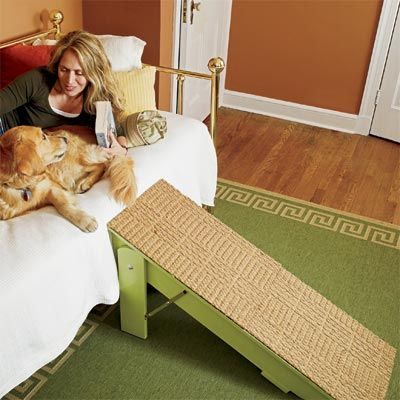
Using a lightweight but sturdy material can make the ramp easier to move without sacrificing durability. Additional features can include using a collapsible design for easy storage, storage space for pet bedding or toys, and handles or wheels for portability.
6. Build a Pet Agility Course
Building an obstacle course for your dog in the backyard is a great way to keep them active and engaged. It can be a fun family project and benefit your dog’s health and behavior. When creating the course, use a mix of obstacles like jumps, tunnels, weave poles, and a seesaw. Make sure each obstacle is the right size for your dog and uses safe, strong materials.
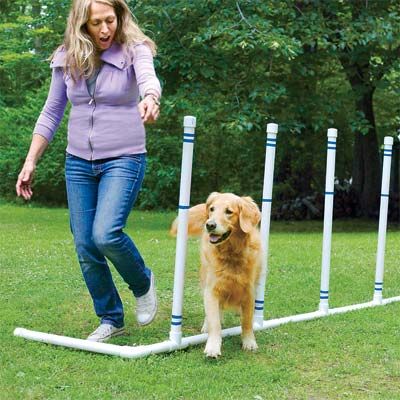
We recommend starting with a few basic obstacles and gradually expanding the course as your pet’s skills improve. Make some elements adjustable or removable to keep the course challenging and allow for easy lawn maintenance. Regularly changing the course layout can keep the experience fresh and exciting
7. Build A Doghouse Like Your House
Creating a doghouse that mimics the style of your own home is a charming way to extend your pet’s living space while adding a unique decorative element to your yard. When designing your mini replica, add key features from your home, such as the roof style, siding material, and color scheme.
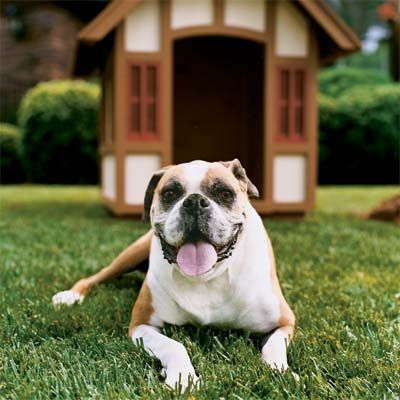
Include fun features like a covered porch area for shade, a raised floor to prevent dampness, and a removable roof for easy cleaning. Add personalized touches, such as a custom name plaque or miniature landscaping. You can also integrate solar-powered lights or small fans to provide additional comfort and convenience.
8. Give Your Pet an Eco-Friendly Makeover
Reducing your pet’s environmental pawprint is a responsible way to care for both your furry friend and the planet. This project involves making thoughtful choices about pet products and practices to minimize waste and promote sustainability.
Start by evaluating your pet’s current supplies and gradually replacing them with eco-friendly alternatives. Look for toys made from recycled materials or natural fibers, and choose biodegradable waste bags for walks. For cats, consider switching to plant-based or recycled paper litter. Using products with minimal or recycled packaging can also help reduce waste.
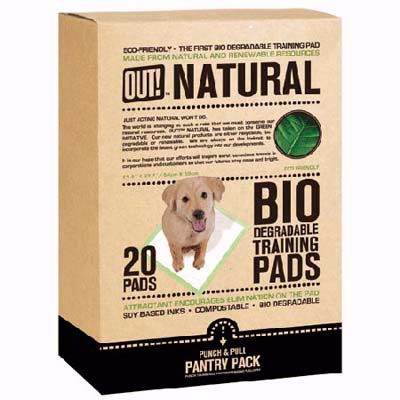
Explore DIY options for pet beds and toys using upcycled materials from your home. This reduces waste and allows you to create unique, personalized items for your pet. Consider making your own pet treats using organic ingredients to reduce waste and provide your pet with healthy snacks.
9. Make Your Home Pet-Safe
Creating a pet-friendly home involves thoughtful planning and minor adjustments to ensure comfort and safety for your furry companions. This project focuses on adapting your living space to accommodate your pet’s needs while maintaining a stylish and functional home for all family members.
Start by checking for potential dangers in your home, like poisonous plants, loose wires, or small objects that pets could swallow. Create safe areas for your pet by using baby gates or marking specific pet-friendly zones. Set up window perches for cats to enjoy the view safely, and consider installing a doggy door for easy backyard access. Keep cleaning supplies and other harmful items out of your pet’s reach.
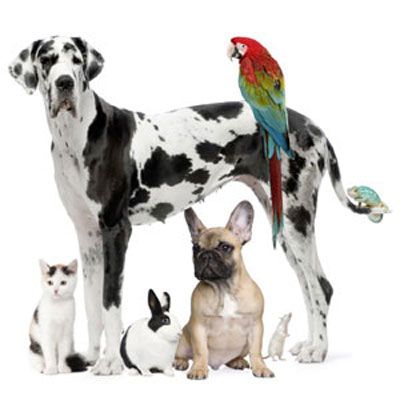
Prioritize pet-friendly materials like scratch-resistant flooring and stain-resistant fabrics. Build built-in feeding stations or litter box enclosures and create cozy nooks with beds in various rooms. Also, keep your pet’s favorite toys and bedding in these spaces.
10. Bring Butterflies Into Your Backyard
Butterflies might not be your typical choice of pets, but they can certainly add beauty and vibrancy to your outdoor space. They create a natural sanctuary for both you and your pets to enjoy. You must cultivate a welcoming environment with the right plants and resources to attract these delicate creatures to your yard.
Research the native butterfly species in your area and the specific plants they prefer for nectar and laying eggs. Then, create a diverse garden with a mix of flowering plants that bloom at various times throughout the season to provide a constant food source. Make sure to include host plants for caterpillars and nectar plants for adult butterflies.
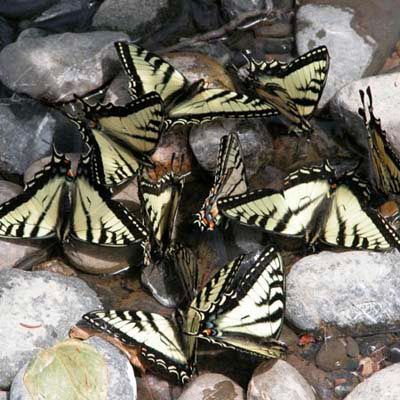
Add shallow water sources, such as a birdbath with pebbles or a butterfly puddling station, to provide necessary minerals and hydration. Don’t use pesticides in your garden, since they can harm butterflies and other beneficial insects. You can add flat rocks in sunny spots for butterflies to bask and warm their wings and windbreaks for sheltered rest spots.
